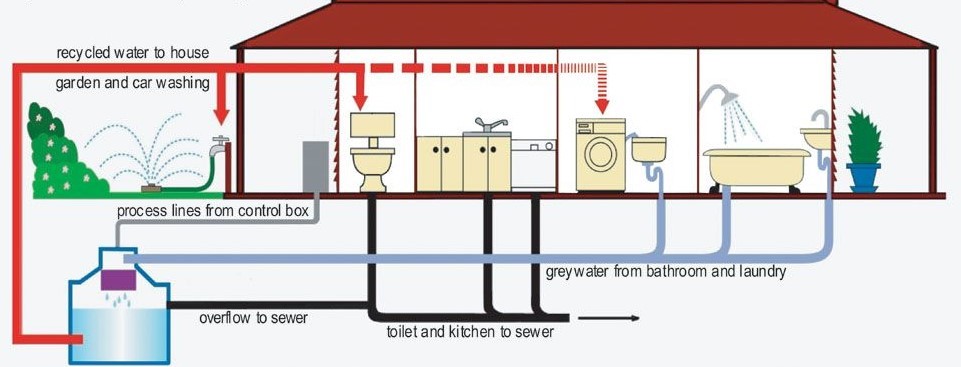Gray water is wastewater generated from processes such as washing dishes, laundry and bathing.
Grey water is different than fresh tap water, which is also known as clearwater.
Grey water is different than blackwater, which is wastewater from toilets.
GREY WATER AND CONSTITUENT PARTICLES
Grey water is the waste water that originates from clothes washer, bath, shower or wash basins.
Grey water may contain fats, oil, grease, hair, lint, soaps, cleansers, fabric softeners and other chemicals. It may have high pH(alkalinity) and also contain increased levels of chemicals such as Chlorides, Sodium, Borax and Sulfates.
Water from kitchen sink or dish washer are not considered as grey water.
BLACK WATER & GREY WATER
Black water is the waste generated from toilets, kitchen sinks, and dishwashers. This should not be reused for domestic purposes on account of high risk of contamination by bacteria, viruses and other pathogens.
Whereas, grey water can be conveniently treated and reused as it is does not have harmful contamination with high risk to humans.
By recycling grey water;
You're getting twice the mileage on your water.
You're saving clearwater.
You are preventing usable greywater from being treated like blackwater which mean reducing the load on sewage treatment centers, saving time and money for everyone and reducing the load
on a septic drain and in the same time generating irrigation water from the waste water by simple low-cost water treatment process.
As a side benefit, Toilets can be flushed with grey water after treating it with a simple water treatment process.
Classification of grey water depending on source;
- Domestic
- Institutional
- Commercial Laundry
- Commercial Kitchens
Domestic waste water distribution:
- 20% Black water from flushing toilets
- 15% Green water from kitchen
- 20% Grey water from Bath
- 35% Grey water from washing machine
- 05% Grey water from hand wash
- 05% Grey water miscellaneous
Cost Estimation: Capital and Operating cost less than ¼ of STP cost
GREY WATER TREATMENT SYSTEM
Grey Water Treatment is the process of removing unwanted suspended solids and materials through effective engineering filtration process and disinfection procedures from grey water and preparing it for reuse.
GREY WATER TREATMENT PLANT
After removing oil contents, the raw grey water shall be led by gravity through drain channels or pipes to a bar screen chamber / strainer. Bar screen chamber / strainer with fine mesh is installed in the chamber to remove all floating materials. The screened grey water flows into the collection sump / raw water tank.
Feed pump will pump the grey water from raw water tank, A suitable coagulant dosing system will be installed for removal of Total Suspended Solids (TSS) depending on the characteristic of grey water followed by self-cleaning multimedia filter followed by self-cleaning activated carbon filter where odor, traces of hydro carbon etc. are removed. The exhausted multimedia and activated carbon filters are backwashed with treated grey water using backwash duty pump. The filtered grey water is thus disinfected by an appropriate automatic chlorine dosing system and the PH of the water will be adjusted by an automatic PH dosing system. the product water then will pass throw a micron cartridge filter which will be installed as a final polishing filter for removing any fine suspended solids. Additionally, ozone / Ultra Violet (UV) sterilizer and Ultra filtration (UF) can be integrated depending on the application requirement. Treated grey water is then transferred and stored for further use.
APPLICATIONS
- Residential areas
- Hotels and resorts
- Staff / labor accommodations
- Remote sites
- Rehabilitation sites
- Offshore installations
ADVANTAGES
- Compact and occupies less space; most of the equipment are skid mounted
- Less complex system and simple operation methods
- Custom engineered system designs for higher capacities / stringent output quality available
- Systems can cater to variable population ranges
- Reducing the waste water by recycling and reusing for flushing, irrigation, discharging to sewer lines and other purposes as applicable.
- Fresh water conservation by reducing the usage
- Ground water recharge
- Growing trees and plants

